Fruiting Body Heterogeneity, Dimorphism and Haustorium-like Structure of Naematelia aurantialba (Jin Er Mushroom)
Abstract
1. Introduction
2. Materials and Methods
2.1. Fungal Specimen, Strains and Culture Conditions
2.2. DNA Extraction and Detection
2.3. Phylogenetic Analysis
2.4. Observation by Microscopy and SEM
3. Results
3.1. Naematelia aurantialba Basidiocarps Are Composed of Two Fungal Species
3.2. Microscopic Structure of Hymenium
3.3. Basidiospores of Naematelia aurantialba Can Germinate into Hyphae or Bud into Yeast-like Conidia
3.4. Dimorphic Switching between Yeast-like Conidia and Pseudohyphae or Hyphae
3.5. Haustorium-like Structure and Morphogenesis
4. Discussion
4.1. Heterogeneity of Jin Er Fruiting Body
4.2. Germination of Basidiospores
4.3. Yeast-like Conidia, Pseudohyphal, and Hyphal Morphogenesis of Naematelia aurantialba
4.4. The Interaction between the N. aurantialba and S. hirsutum
5. Conclusions
Supplementary Materials
Author Contributions
Funding
Institutional Review Board Statement
Informed Consent Statement
Data Availability Statement
Conflicts of Interest
References
- Bandoni, R.J.; Zang, M. On an undescribed Tremella from China. Mycologia 1990, 82, 270–273. [Google Scholar] [CrossRef]
- Liu, X.Z.; Wang, Q.M.; Theelen, B.; Groenewald, M.; Bai, F.Y.; Boekhout, T. Phylogeny of tremellomycetous yeasts and related dimorphic and filamentous basidiomycetes reconstructed from multiple gene sequence analyses. Stud. Mycol. 2015, 81, 1–26. [Google Scholar] [CrossRef] [PubMed]
- Kiho, T.; Kochi, M.; Usui, S.; Hirano, K.; Aizawa, K.; Inakuma, T. Antidiabetic effect of an acidic polysaccharide (TAP) from Tremella aurantia and its degradation product (TAP-H). Biol. Pharm. Bull. 2001, 24, 1400–1403. [Google Scholar] [CrossRef] [PubMed][Green Version]
- Fan, J.; Chu, Z.; Li, L.; Zhao, T.R.; Yin, M.; Qin, Y.Y. Physicochemical properties and microbial quality of Tremella aurantialba packed in antimicrobial composite films. Molecules 2017, 22, 500. [Google Scholar] [CrossRef] [PubMed]
- Yuan, Q.X.; Zhang, X.D.; Ma, M.Y.; Long, T.; Xiao, C.L.; Zhang, J.; Liu, J.K.; Zhao, L.Y. Immunoenhancing glucuronoxylomannan from Tremella aurantialba Bandoni et Zang and its low-molecular-weight fractions by radical depolymerization: Properties, structures and effects on macrophages. Carbohyd Polym. 2020, 238, 116–184. [Google Scholar] [CrossRef] [PubMed]
- Gui, M.Y.; Ma, S.B.; Guo, X. The Macrofungi in Southwest of China; Shanghai Scientific and Technical Publishers: Shanghai, China, 2016. [Google Scholar]
- Yang, Y.; Liu, Q.; Zhang, Z.X.; Dong, C.H. First report of bacterial brown rot disease caused by Ewingella americana on cultivated Naematelia aurantialba in China. Plant Dis. 2023, 107, 2513. [Google Scholar] [CrossRef] [PubMed]
- Yan, Y.; Wang, M.; Chen, N.; Wang, X.; Fu, C.; Li, Y.; Gan, X.; Lv, P.; Zhang, Y. Isolation, structures, bioactivities, application and future prospective for polysaccharides from Tremella aurantialba: A review. Front. Immunol. 2022, 13, 1091210. [Google Scholar] [CrossRef] [PubMed]
- Yu, F.; Guerin-Laguette, A.; Wang, Y. Edible Mushrooms and Their Cultural Importance in Yunnan, China. In Mushrooms, Humans and Nature in a Changing World; Pérez-Moreno, J., Guerin-Laguette, A., Flores Arzú, R., Yu, F.Q., Eds.; Springer: Cham, Switzerland, 2020. [Google Scholar]
- Tian, G.T.; Zhao, D.D.; Zhao, Y.C. Study on technology for spawn preparation for Tremella aurantialba. Southwest China J. Agric. Sci. 2010, 23, 1620–1624. [Google Scholar]
- Liu, S.C.; Li, R.C.; Ma, B.P.; Luo, X.Y.; Li, M.J.; Cao, Y.; Wen, S.F.; Zhou, Z.F.; Yang, L.L. Research on cultivation techniques of Naematelia aurantialba. Edible Fungi China 2019, 38, 94–99. (In Chinese) [Google Scholar]
- Wu, Q. Identification and Preparation of Effective Strains of Naematelia aurantialba. Master’s Thesis, Hebei Agricultural University, Baoding, China, 2020. [Google Scholar]
- Ye, B. Identification and cultivation of Golden Tremella (Tremella aurantialba). Master’s Thesis, Fujian Agricultural and Forestry University, Fuzhou, China, 2012. [Google Scholar]
- Choi, Y.W.; Hyde, K.D.; Ho, W.H. Single spore isolation of fungi. Fungal Divers. 1999, 3, 29–38. [Google Scholar]
- Doyle, J.J.; Doyle, J.L. A rapid DNA isolation procedure for small quantities of fresh leaf tissue. Phytochem. Bull. 1987, 19, 11–15. [Google Scholar]
- White, T.J.; Bruns, T.; Lee, S.; Taylor, J. Amplification and direct sequencing of fungal ribosomal RNA genes for phylogenetics. In PCR Protocols: A Guide to Methods and Applications; Academic Press: San Diego, CA, USA, 1990; pp. 315–322. [Google Scholar]
- Tamura, K.; Stecher, G.; Kumar, S. MEGA11: Molecular Evolutionary Genetics Analysis Version 11. Mol. Biol. Evol. 2021, 38, 3022–3027. [Google Scholar] [CrossRef] [PubMed]
- FigTree, Version 1.4.2. 2014. Available online: http://tree.bio.ed.ac.uk/software/figtree/ (accessed on 3 January 2022).
- Nebesářová, J. Essential methods of plant sample preparation for high-resolution scanning electron microscopy at room temperature. Methods Mol. Biol. 2019, 1992, 63–76. [Google Scholar] [PubMed]
- Yang, Y.; Li, C.L.; Ni, S.J.; Zhang, H.F.; Dong, C.H. Ultrastructure and development of acanthocytes, specialized cells in Stropharia rugosoannulata, revealed by scanning electron microscopy (SEM) and cryo-SEM. Mycologia 2021, 113, 65–77. [Google Scholar] [CrossRef] [PubMed]
- Boidin, J. Nuclear behaviour in the mycelium and the evolution of the Basidiomycetes. In Evolution in the Higher Basidiomycetes; Petersen, R.H., Ed.; University of Tennessee Press: Knoxville, TN, USA, 1971; pp. 129–148. [Google Scholar]
- Coates, D.; Rayner, A.; Todd, N. Mating behaviour, mycelial antagonism and the establishment of individuals in Stereum hirsutum. Trans. Br. Mycol. Soc. 1981, 76, 41–51. [Google Scholar] [CrossRef]
- Huang, M.; Hebert, A.S.; Coon, J.J.; Hull, C.M. Protein composition of infectious spores reveals novel sexual development and germination factors in Cryptococcus. PLoS Genet. 2015, 11, e1005490. [Google Scholar] [CrossRef] [PubMed]
- Zugmaier, W.; Bauer, R.; Oberwinkler, F. Mycoparasitism of some Tremella species. Mycologia 1994, 86, 49–56. [Google Scholar] [CrossRef]
- Wu, R. Preliminary Study on Mycelial Interaction between Tremella fuciformis and Hypoxylon sp. Master’s Thesis, Huazhong Agricultural University, Wuhan, China, 2008. [Google Scholar]
- Roberts, P. British Tremella species II: T. encephala, T. steidleri and T. foliacea. Mycologist 1999, 13, 127–131. [Google Scholar] [CrossRef]
- Cao, Y.; Yang, L.L.; Li, R.C.; Feng, F.J.; Li, M.J.; Luo, X.Y.; Shen, Z.H.; Lu, Q.Q. A preliminary study on composition of fungal species and nutrient transportation in Naematelia aurantialba culture. Acta Edulis Fungi 2022, 29, 48–53. [Google Scholar]
- Chen, C.J. Morphological and molecular studies in the genus Tremella. In Bibliotheca Mycologica; der Gebriider Borntraeger Verlagsbuchhandlung: Berlin, Germany, 1998; pp. 1–225. [Google Scholar]
- Xu, B.R.; Xu, D.Y. Characteristics and differences of Tremella fuciformis and associated fungi. Edible Fungi China 1997, 2, 10–12. [Google Scholar]
- Zhang, B.Z.; Zhu, L.Y.; Zhang, W.D. Study on the morphology of Tremella fuciformis mycelium and the preparation of Tremella fuciformis mother species. Edible Fungi China 1995, 14, 17–20. (In Chinese) [Google Scholar]
- Zhao, Y.; Liu, X.Z.; Bai, F.Y. Four new species of Tremella (Tremellales, Basidiomycota) based on morphology and DNA sequence data. MycoKeys 2019, 27, 75–95. [Google Scholar] [CrossRef] [PubMed]
- Khunnamwong, P.; Surussawadee, J.; Ribeiro, J.R.A.; Hagler, A.N.; Limtong, S. Tremella saccharicola f.a., sp. nov., a novel tremellaceous yeast species isolated from tropical regions. Int. J. Syst. Evol. Microbiol. 2019, 69, 2010–2016. [Google Scholar] [CrossRef] [PubMed]
- Tuovinen, V.; Millanes, A.M.; Freire-Rallo, S.; Rosling, A.; Wedin, M. Tremella macrobasidiata and Tremella variae have abundant and widespread yeast stages in Lecanora lichens. Environ. Microbiol. 2021, 23, 2484–2498. [Google Scholar] [CrossRef]
- Navarro, H.M.C.; Félix, C.R.; Tavares, V.D.F.S.; de Sousa, F.M.P.; Santos, A.R.O.; Morais, P.B.; Rosa, C.A.; Valente, P.; Landell, M.F. Tremella ananatis sp. nov. and Tremella lamprococci sp. nov., two yeast species associated with bromeliads. Int. J. Syst. Evol. Microbiol. 2022, 72, 005261. [Google Scholar] [CrossRef] [PubMed]
- Li, Y.; Tang, H.; Zhao, W.; Yang, Y.; Fan, X.; Zhan, G.; Li, J.; Sun, S. Study of dimorphism transition mechanism of Tremella fuciformis based on comparative proteomics. J. Fungi 2022, 8, 242. [Google Scholar] [CrossRef] [PubMed]
- Liu, J. Study on the Differences of Dimorphic Cells in Tremella fuciformis. Master’s Thesis, Huazhong Agricultural University, Wuhan, China, 2008. [Google Scholar]
- Holliday, R. The genetics of Ustilago maydis. Genet. Res. 1961, 2, 204–230. [Google Scholar] [CrossRef]
- Christensen, J.J. Corn Smut Caused by Ustilago maydis; American Phytopathological Society: St. Paul, MN, USA, 1963. [Google Scholar]
- Oberwinkler, F. Yeasts in Pucciniomycotina. Mycol. Prog. 2017, 16, 831–856. [Google Scholar] [CrossRef]
- Begerow, D.; Schaffer, A.M.; Kellner, R.; Youkov, A.; Kemler, M.; Oberwinkler, F.; Bauer, R. Ustilaginomycotina. In Mycota VII Systematics and Evolution Part A; McLaughlin, D.J., Spatafora, J.W., Eds.; Springer: Berlin/Heidelberg, Germany, 2014; pp. 295–329. [Google Scholar]
- Weiss, M.; Bauer, R.; Sampaio, J.P.; Oberwinkler, F. Tremellomycetes and related groups. In Mycota VII Systematics and Evolution Part A; McLaughlin, D.J., Spatafora, J.W., Eds.; Springer: Berlin/Heidelberg, Germany, 2014; pp. 331–355. [Google Scholar]
- Kijpornyongpan, T.; Aime, M.C. Investigating the smuts: Common cues, signaling pathways, and the role of MAT in dimorphic switching and pathogenesis. J. Fungi 2020, 6, 368. [Google Scholar] [CrossRef] [PubMed]
- He, D.; Zhang, X.; Gao, S.; You, H.; Zhao, Y.; Wang, L. Transcriptome analysis of dimorphic fungus Sporothrix schenckii exposed to temperature stress. Int. Microbiol. 2021, 24, 25–35. [Google Scholar] [CrossRef] [PubMed]
- Yang, E.; Chow, W.N.; Wang, G.; Woo, P.C.; Lau, S.K.; Yuen, K.Y.; Lin, X.; Cai, J.J. Signature gene expression reveals novel clues to the molecular mechanisms of dimorphic transition in Penicillium marneffei. PLoS Genet. 2014, 10, e1004662. [Google Scholar] [CrossRef]
- Sil, A. Molecular regulation of Histoplasma dimorphism. Curr. Opin. Microbiol. 2019, 52, 151–157. [Google Scholar] [CrossRef] [PubMed]
- Aggarwal, S.; Mishra, S. Yeast-mycelial dimorphism in Pichia pastoris SMD1168 is triggered by nutritional and environmental factors. Curr. Microbiol. 2022, 79, 190. [Google Scholar] [CrossRef] [PubMed]
- Sipiczki, M.; Takeo, K.; Yamaguchi, M.; Yoshida, S.; Miklos, I. Environmentally controlled dimorphic cycle in a fission yeast. Microbiology 1998, 144, 1319–1330. [Google Scholar] [CrossRef] [PubMed]
- Furuya, K.; Niki, H. The DNA damage checkpoint regulates a transition between yeast and hyphal growth in Schizosaccharomyces japonicus. Mol. Cell. Biol. 2010, 30, 2909–2917. [Google Scholar] [CrossRef] [PubMed]
- Tian, X.; He, G.J.; Hu, P.; Chen, L.; Tao, C.; Cui, Y.L.; Shen, L.; Ke, W.; Xu, H.; Zhao, Y.; et al. Cryptococcus neoformans sexual reproduction is controlled by a quorum sensing peptide. Nat. Microbiol. 2018, 3, 698–707. [Google Scholar] [CrossRef] [PubMed]
- Maidan, M.M.; Thevelein, J.M.; Van Dijck, P. Carbon source induced yeast-to-hypha transition in Candida albicans is dependent on the presence of amino acids and on the G-protein-coupled receptor Gpr1. Biochem. Soc. Trans. 2005, 33, 291–293. [Google Scholar] [CrossRef] [PubMed]
- Guan, G.; Tao, L.; Li, C.; Xu, M.; Liu, L.; Bennett, R.J.; Huang, G. Glucose depletion enables Candida albicans mating independently of the epigenetic white-opaque switch. Nat. Commun. 2023, 14, 2067. [Google Scholar] [CrossRef] [PubMed]
- Woods, J.P. Knocking on the right door and making a comfortable home: Histoplasma capsulatum intracellular pathogenesis. Curr. Opin. Microbiol. 2003, 6, 327–331. [Google Scholar] [CrossRef] [PubMed]
- Van, R.P.; Martel, A.; D’Herde, K.; Brutyn, M.; Croubels, S.; Ducatelle, R.; Haesebrouck, F.; Pasmans, F. Germ tube mediated invasion of Batrachochytrium dendrobatidis in amphibian skin is host dependent. PLoS ONE 2012, 7, e41481. [Google Scholar]
- Koch, R.A.; Herr, J.R. Transcriptomics reveals the putative mycoparasitic strategy of the mushroom Entoloma abortivum on species of the mushroom genus Armillaria. mSystems 2021, 6, e0054421. [Google Scholar] [CrossRef] [PubMed]
- Moore, D.; Robson, G.D.; Trinci, A.P. 21st Century Guidebook to Fungi with CD; Cambridge University Press: Cambridge, UK, 2011; pp. 1–640. [Google Scholar]
- Sun, J.Z.; Liu, X.Z.; McKenzie, E.H.C.; Jeewon, R.; Liu, J.K.; Zhang, X.L.; Zhao, Q.; Hyde, K.D. Fungicolous fungi: Terminology, diversity, distribution, evolution, and species checklist. Fungal Divers. 2019, 95, 337–430. [Google Scholar] [CrossRef]
- Grube, M. Observations on Biatoropsis usnearum, a lichenicolous heterobasidiomycete, and other gall-forming lichenicolous fungi, using different microscopical techniques. Mycol. Res. 2001, 105, 1116–1122. [Google Scholar] [CrossRef]
- Zugmaier, W.; Oberwinkler, F. Tremelloid haustorial cells with haustorial filaments and potential host range of Tremella mesenterica. Nord. J. Bot. 1995, 15, 207–213. [Google Scholar] [CrossRef]
- Olive, L.S. Notes on the Tremellales of Georgia. Mycologia 1947, 39, 90–108. [Google Scholar] [CrossRef] [PubMed]
- Watling, R. Dimorphism in Entoloma abortivum. Bull. Société Linnéenne Lyon 1974, 43, 449–470. [Google Scholar]
- Lindner Czederpiltz, D.L.; Volk, T.J.; Burdsall, H.H., Jr. Field observations and inoculation experiments to determine the nature of the carpophoroids associated with Entoloma abortivum and Armillaria. Mycologia 2001, 93, 841–851. [Google Scholar] [CrossRef]
- Iliev, I.D.; Underhill, D.M. Striking a balance: Fungal commensalism versus pathogenesis. Curr. Opin. Microbiol. 2013, 16, 366–373. [Google Scholar] [CrossRef] [PubMed]
- Boddy, L. Interactions between fungi and other microbes. In The Fungi, 3rd ed.; Academic Press: Cambridge, MA, USA, 2016; pp. 337–360. [Google Scholar]
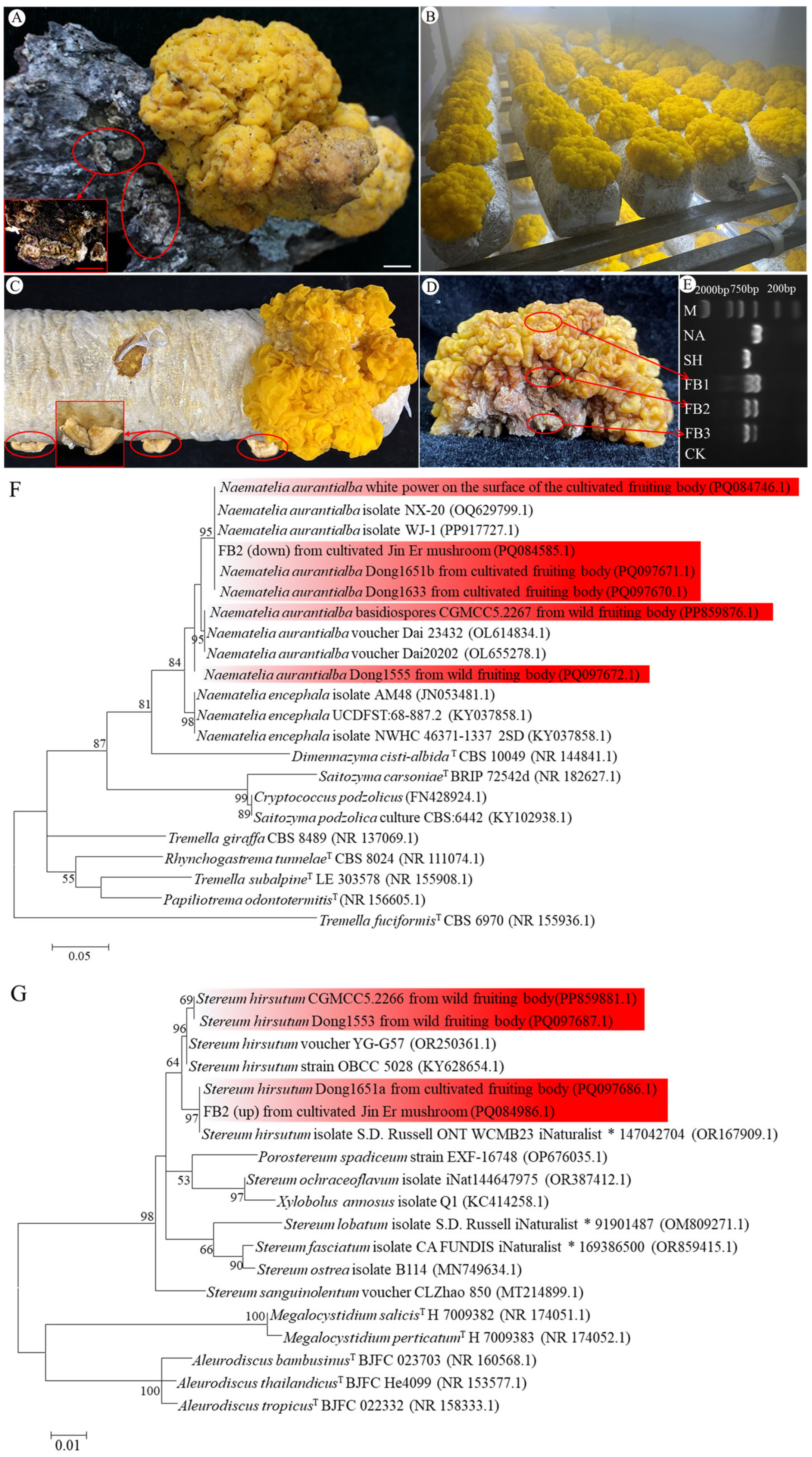
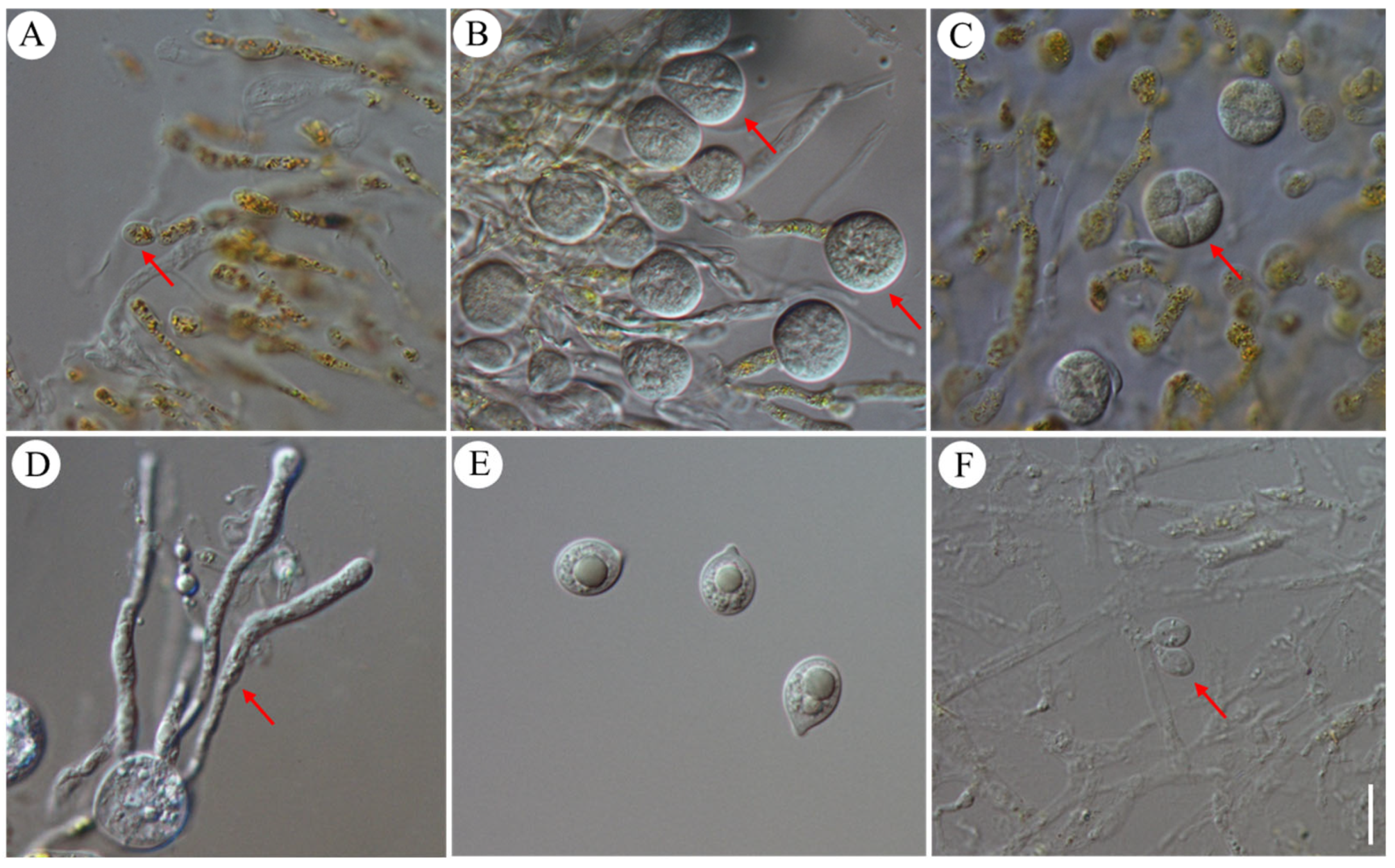
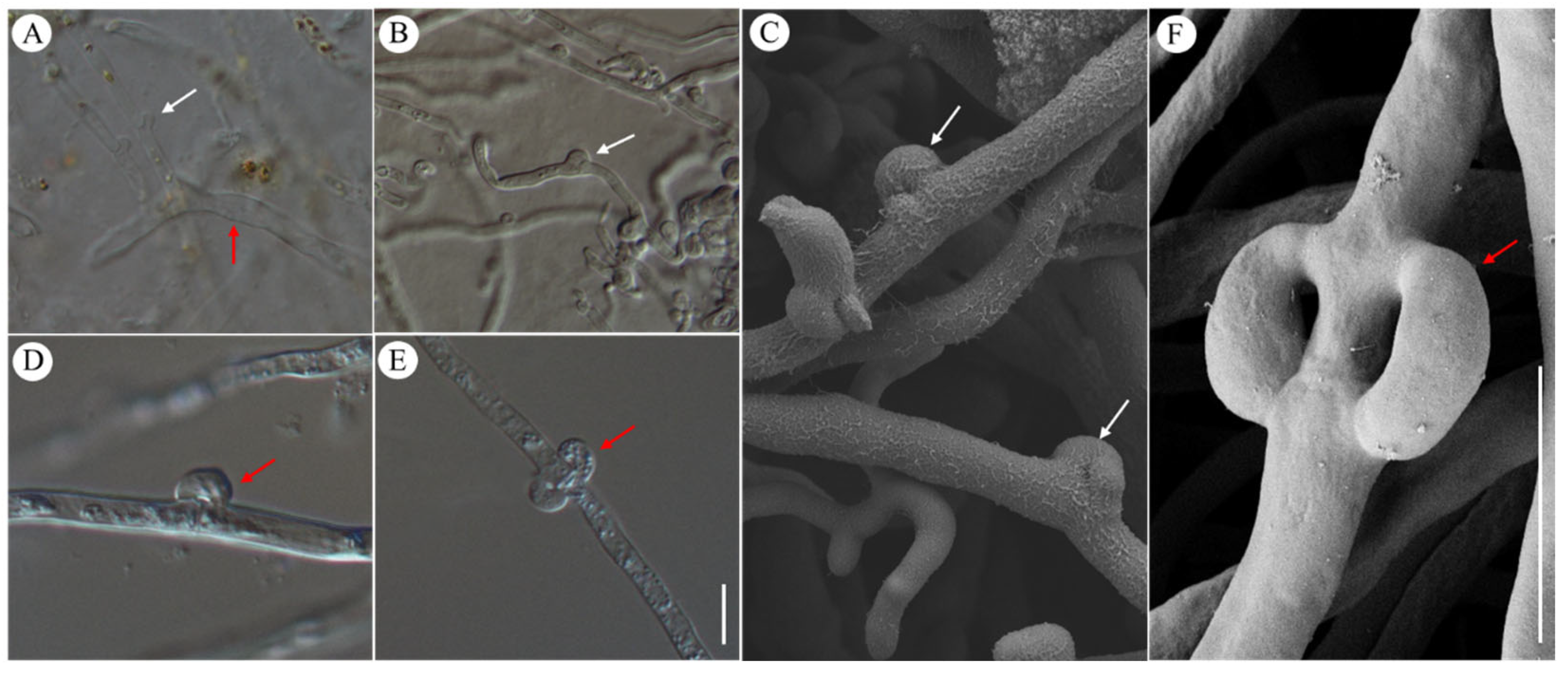
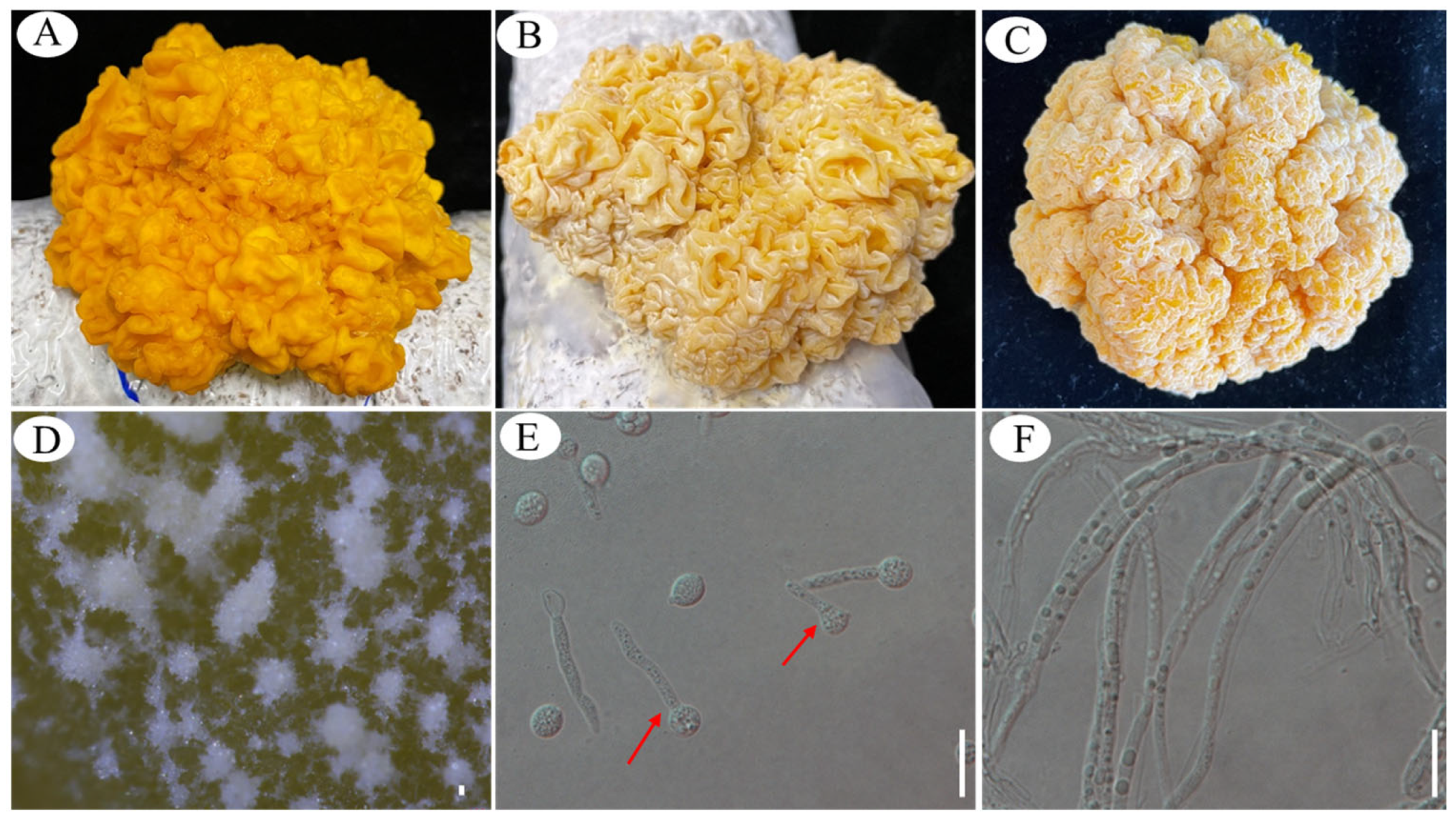

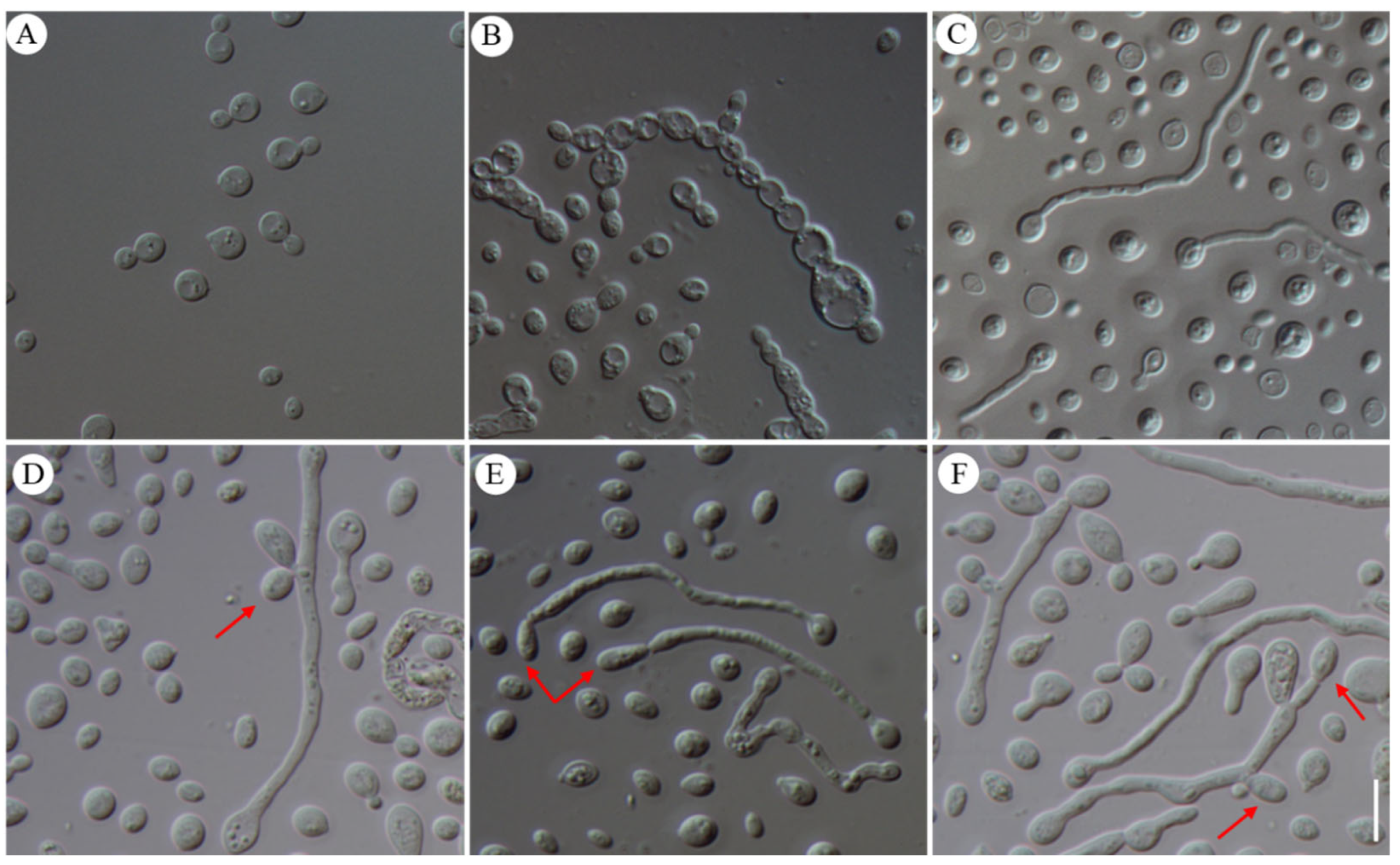

Disclaimer/Publisher’s Note: The statements, opinions and data contained in all publications are solely those of the individual author(s) and contributor(s) and not of MDPI and/or the editor(s). MDPI and/or the editor(s) disclaim responsibility for any injury to people or property resulting from any ideas, methods, instructions or products referred to in the content. |
© 2024 by the authors. Licensee MDPI, Basel, Switzerland. This article is an open access article distributed under the terms and conditions of the Creative Commons Attribution (CC BY) license (https://creativecommons.org/licenses/by/4.0/).
Share and Cite
Yang, Y.; Dong, C. Fruiting Body Heterogeneity, Dimorphism and Haustorium-like Structure of Naematelia aurantialba (Jin Er Mushroom). J. Fungi 2024, 10, 557. https://doi.org/10.3390/jof10080557
Yang Y, Dong C. Fruiting Body Heterogeneity, Dimorphism and Haustorium-like Structure of Naematelia aurantialba (Jin Er Mushroom). Journal of Fungi. 2024; 10(8):557. https://doi.org/10.3390/jof10080557
Chicago/Turabian StyleYang, Ying, and Caihong Dong. 2024. "Fruiting Body Heterogeneity, Dimorphism and Haustorium-like Structure of Naematelia aurantialba (Jin Er Mushroom)" Journal of Fungi 10, no. 8: 557. https://doi.org/10.3390/jof10080557
APA StyleYang, Y., & Dong, C. (2024). Fruiting Body Heterogeneity, Dimorphism and Haustorium-like Structure of Naematelia aurantialba (Jin Er Mushroom). Journal of Fungi, 10(8), 557. https://doi.org/10.3390/jof10080557






